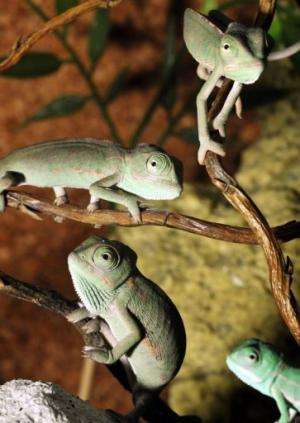Out of Africa: Chameleons migrated by sea

Chameleons took to the waves to migrate from Africa to Madagascar about 65 million years ago, said a study published on Wednesday that seeks to resolve a roiling biological debate.
Chameleons are famous for the extraordinary ability of some species to change colour, and for a lightning-fast talent to catch prey with their tongue.
Biologists, though, are bemused by a wider question: Where on Earth did chameleons come from?
The vast majority of the 195 chameleon species today are found in Africa and Madagascar, both once part of a supercontinent called Gondwana that broke apart some 120 million years ago.
During that split, the African continent and the island of Madagascar became separated by a sea trough that today is 400 kilometres (250 miles) wide.
Fossil evidence suggests the first chameleons only showed up after the breakup—but scientists have long disagreed about where.
The new study, based on a genetic analysis of 174 chameleon species, says the migration came from Africa.
It was led by lizard pioneers who probably hitched a ride on rafts of floating debris washed downstream in big African rivers during floods, suggested its authors.
"What we did was estimate the time period when various related chameleons on Africa and Madagascar diverged," said lead author Krystal Tolley at the South African National Biodiversity Institute in Cape Town.

"We found out this was probably first, in the late Cretaceous, 65 million years ago, and then again in the Oligocene period, about 45 million years ago," Tolley said in an email to AFP.
"We concluded that (both dispersal events were) more likely to be from Africa to Madagascar but we then also backed this up by using information on the direction of oceanic currents in those very same time periods."
During the late Cretaceous and the Oligocene, currents actually flowed from Africa toward Madagascar, the opposite of today's flow, a discovery that was "the icing on the cake, as far as we were concerned", she said.
Another big study on chameleon origins, published in 2002, had concluded the lizards originated in Madagascar.
Ancestral lizards crossed the present-day Mozambique Channel to Africa, where they underwent species differentiation, evolving in habitat niches shaped by climate and landscape change, the authors of that study had said.
Those findings were based on DNA analysis of about 40 percent of chameleon species and used a technique called the molecular clock to estimate the pace of evolution and reconstruct the ancient family tree.
"(...) (We) were a bit suspicious of this line of thought, and decided to investigate their origins more closely," said Tolley of the Madagascar-to-Africa theory.
Raft dispersion by animals and plants, sometimes across hundreds of kilometres, is a known if rare phenomenon, she added.
"It would be a difficult journey, so it probably does not happen often and the currents have to be in the right direction, too. For chameleons, it has likely occurred only a few times. Between African and Madagascar, we think it only has occurred twice."
Elsewhere in the Indian Ocean, chameleons had travelled from Africa to the Seychelles Islands on one occasion, and in the Atlantic they managed to make it to Bioko Island in the Gulf of Guinea, said Tolley.
(c) 2013 AFP

















